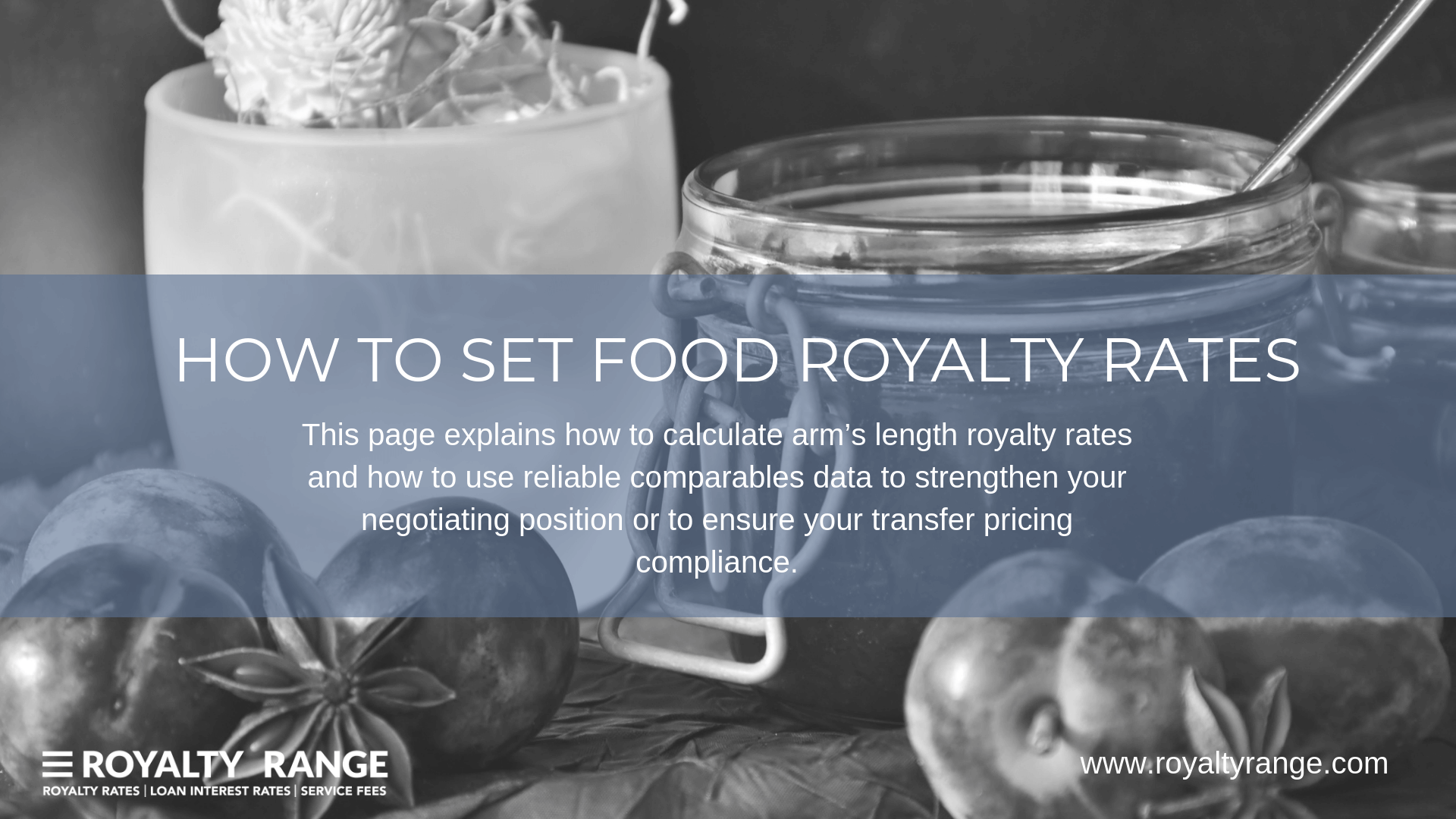How to set food royalty rates
Article – April 2019 | RoyaltyRange

When you license your food-related intellectual property, you need to set royalty rates. This page explains how to calculate arm’s length royalty rates and how to use reliable comparables data to strengthen your negotiating position or to ensure your transfer pricing compliance. We also provide some average food royalty rates that you can use for your analysis or transfer pricing documentation.
Whether you are negotiating a license agreement, carrying out a transfer pricing analysis or valuing intellectual property, you can find the data you need in the RoyaltyRange database. To start your search, go to the bottom of this page, where you can order food royalty rates reports.
Average food royalty rates
Before we discuss how to set your food royalty rates, we thought we would provide you with a list of reports for different food categories and intellectual property types, including brands and trademarks, readily available for purchase.
- Coffee and general food products (brands)
- Dairy products, cheeses and pasta (brands and know-how)
- Food (trademarks)
- Fruits (trademarks and trade names)
- Meat and pâté products (trademarks)
- Meat, prepared meals and dishes, soups, canned food, vegetables, salami and sausage products (trademarks)
- Pet food (brands and know-how)
- Selection, processing and packing of legumes and cereals (trademarks)
- Soft drinks (brands)
- Wine (brands)
You might like to use these food market royalty rate benchmarks for your analysis. You can also search the RoyaltyRange database for the specific royalty rates and license agreements you need.
Setting food royalty rates: choosing your royalty structure
Before you can set your food royalty rates, you need to decide on a payment structure.
A royalty rate is usually set as a percentage of the revenue generated by your licensed intellectual property. This option is mutually beneficial to both parties, as the amount the licensee pays reflects the revenue generated by the licensed intellectual property. You will need to determine an appropriate royalty base (usually gross or net sales) and royalty percentage (see below).
Alternatively, a royalty rate can be a fixed fee instead of a royalty percentage. A fixed royalty structure means that the licensor receives the same payment, regardless of sales or profits.
How to work out a fair royalty percentage
There are a number of ways to determine a fair royalty percentage for your food and beverage royalty rates. The two main approaches are the income approach and market (or transactional) approach. Whichever approach you take, you need to have access to reliable comparables data to identify the appropriate benchmarks for your food and beverage royalty rates.
Also, it is a good idea to try multiple methods and corroborate your results. This helps ensure the royalty rates you set are at arm’s length (reflect market rates). Please check your local regulations regarding the applicability of different approaches and methodologies.
Market approach
A market approach bases royalty rates on royalties earned in comparable license agreements between unrelated parties. This provides you with market rates for comparable intellectual property in a comparable transaction. You can use these to determine arm’s length royalty rates for your licensed intellectual property.
One market-based method is the comparable uncontrolled transaction (CUT) method, which is similar to the comparable uncontrolled price (CUP) method for transfer pricing analyses.
This approach requires you to have access to recent license agreements that are sufficiently comparable in terms of intellectual property, market and circumstances. You can analyze these agreements to find the median and interquartile range of the market royalty rates.
Income approach
Alternatively, with an income approach, you base your royalty rates on the expected income generated by your intellectual property. You need to start by identifying the earning potential of the intellectual property you are licensing.
The profit split and residual income methods are two examples of income-based methods you could use.
Another income-based method is the 25% rule. This concept states that, as a rule of thumb, if a licensee is selling a product or service that incorporates the licensor’s intellectual property, the licensee should pay a royalty of 25% of the gross profit made from the sales of that product or service. In 2011, however, the US Federal Circuit rejected the 25% rule’s use as a rule of thumb.
You should check the results of your calculation against the royalty rates earned in comparable license agreements. By doing this, you can make sure your royalty rates are at arm’s length.
Find comparable license agreements today
One of the most reliable ways to calculate food royalty rates is to base them on the royalties earned in comparable third-party license agreements. Even if you use an income-based calculation method to determine your royalty rates, you should check your royalties against those achieved in comparable license agreements to make sure they’re at arm’s length.
The RoyaltyRange database makes it quick and easy for you to determine arm’s length food royalty rates for your intellectual property. It also strengthens your position when negotiating a license agreement as it gives you relevant market data to support your proposed rates.
To find food royalty rates today, use the RoyaltyRange database. You can either download readymade royalty rate reports for general food categories, or use our One Search service to filter your search for specific royalty rates (this option takes a few hours but enables you to further refine your royalty rates search in terms of intellectual property type, keyword, NACE Rev. 2 code, SIC code, date of license agreement, territory and exclusivity). Alternatively, you can purchase food royalty rate benchmarking studies prepared by us.